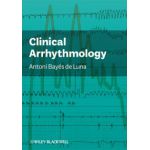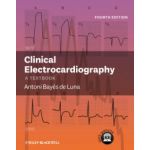Clinical Arrhythmology

Preț: 673,20 lei
Disponibilitate: la comandă (vezi secțiunea "Despre livrare")
Autor: Antonio Bayés de Luna
ISBN: 9780470656365
Editura: Wiley-Blackwell
Anul publicării: 2011
Pagini: 424
DESCRIERE
The study and management of abnormal heart rhythms is the core of Electrophysiology, but the successful identification and management of arrhythmias is important to a much wider range of physicians, from trainees in cardiology to general clinical cardiologists to practitioners in other areas of specialization, for example internists. This book is a thorough overview of clinical arrhythmology designed to help general clinical cardiologists and trainees in the fields of clinical cardiology and electrophysiology achieve the competency they need for clinical practice or for further specialization in the topics covered within the book. Part 1 Anatomical, Electrophysiological and Clinical Considerations, and Mechanisms of Cardiac Arrhythmias Contents Introduction General references recommended Part 1 1. Clinical aspects of arrhythmias 1. 1. Definition of arrhythmia 1. 2. Classification 1. 3. Clinical significance and symnptoms 1. 3. 1. Arrhythmias and sudden death 1. 3. 2. Arrhythmias and severe clinical complications: Syncope 1. 3. 3. Arrhythmias and unpleasant, non severe symptoms: palpitations 1. 3. 4. Asymptomatic arrhythmias 1. 4. The importance of the clinical history and physical examination, in thye diagnosis and treatment of arrhythmias 1. 5. The ECG and other techniques 1. 6. Electrocardiographic diagnosis of arrhythmias: preliminary considerations 2. Anatomical and electrophysiological basis 2. 1. Anatomical characteristics 2. 1. 1. Ultrastructural characteristics of cardiac muscle cells 2. 1. 2. Anatomy of specific conduction system 2. 2. Electrophysiological characteristics 2. 2. 1. Slow and fast response cells 2. 2. 2. Ion channels 2. 2. 3. Transmembrane diastolic potential (TDP) and transmembrane action potential (TAP) of slow and fast response cells 2. 2. 4. Automatism 2. 2. 5. Conduction of stimulus 2. 2. 6. Cardiac activation: Excitation-contraction coupling 2. 2. 7. From cellular electrogram to ECG in humans 3. Electrophysiological mechanisms 3. 1. Mechanisms responsible for active cardiac arrhythmias 3. 1. 1. Active cardiac arrhythmias with fixed coupling interval 3. 1. 1. 1. Abnormal generation of stimulus 3. 1. 1. 2. Reentry 3. 1. 1. 3. Other mechanisms 3. 1. 2. Active cardiac arrhythmias with variable coupling interval: the parasystole 3. 2. Mechanisms leading to passive arrhythmias 3. 2. 1. Depression of automaticity 3. 2. 2. Depression of conduction 3. 2. 2. 1. Heart block 3. 2. 2. 2. Aberrant conduction 3. 2. 2. 3. Concealed conduction Part 2 Electrocardiographic diagnosis of arrhythmias 4. Active supraventricular arrhythmias 4. 1. Premature supraventricular complexes 4. 2. Sinus tachycardia 4. 3. Monomorphic atrial tachycardia: due to an ectopic focus (MAT-EF) and due to macroreentrey (MAT-MR) 4. 4. Junctional reentrant (reciprocating) tachycardia: paroxysmal and incessant 4. 5. AV junctional ectopic tachycardia due to ectopic focus 4. 6. Chaotic atrial tachycardia 4. 7. Atrial fibrillation (AF) 4. 8. Atrial flutter (AFL) 4. 9. Supraventricular tachyarrhythmias and atrial-wave morphology: monomorphic or polymorphic morphology 4. 10. Differential diagnosis of supraventricular arrhythmias with regular RR intervals and narrow QRS 4. 11. Electrocardiographic diagnosis of the paroxysmal supraventricular tachycardias: A sequential approach 5. Active ventricular arrhythmias 5. 1. Premature ventricular complexes 5. 2. Ventricular tachycardias 5. 2. 1. Monomorphic ventricular tachycardia 5. 2. 1. 1. Classical sustained ventricular tachycardia 5. 2. 1. 2. Other monomorphic ventricular tachycardia 5. 2. 2. Polymorphic ventricular tachycardia 5. 3. Ventricular flutter 5. 4. Ventricular fibrillation 6. Passive arrhythmias 6. 1. Escape complex and escape rhythm 6. 2. Sinus bradycardia by depression of the automatism 6. 3. Sinoatrial blocks 6. 4. Atrial blocks 6. 5. Atrioventricular blocks 6. 6. Ventricular blocks 6. 7. Cardiac arrest 6. 8. The pacemakers ECG 6. 9. Clinical, prognostic, and therapeutic implications of the passive arrhythmias 7. Analytical study of arrhythmias 7. 1. Determination of the presence of a dominant rhythm 7. 2. Atrial deflection analysis 7. 3. QRS complex analysis 7. 4. Atrioventricular relationship analysis 7. 5. Premature complexes analysis 7. 6. Pauses analysis 7. 7. Delayed complexes analysis 7. 8. Analysis of the variable morphology complexes 7. 9. Analysis of persistent or repetitive arrhythmias: Bigeminal rhythm 7. 10. Differential diagnosis between arrhythmias under particular conditions Part 3 The ECG and arrhythmias and risk of sudden death in different heart diseases and situations. 8. Ventricular pre-excitation 8. 1. Concept and types of preexcitation 8. 2. WPW- type preexcitation: WPW syndrome 8. 3. Atpical preexcitation 8. 4. Preexcitation type short PR interval 9. Inherited heart diseases 9. 1. Cardiomyopathies 9. 1. 1. Hypertrophic cardiomyopathy 9. 1. 2. Arrhythmogenic right ventricular dysplasia cardiomyopathy 9. 1. 3. Spongiform or non compacted cardiomyopathy 9. 1. 4. Dilated cardiomyopathy 9. 2. Specific conduction system involvement: Lenegre syndrome 9. 3. Ionic channel disorders in the absence of apparent structural heart disease: channelopathies 9. 3. 1. Long QT syndrome 9. 3. 2. Short QT syndrome 9. 3. 3. Brugada syndrome 9. 3. 4. Catecholaminergic polymorphic ventricular tachycardia 9. 3. 5. Atrial fibrillation of genetic origin 9. 3. 6. Familial torsades de pointes ventricular tachycardia 9. 3. 7. Other possible channelopathies 9. 3. 8. Idiopathic ventricular fibrillation 10. Other ECG patterns of risk 10. 1. Severe sinus bradycardia 10. 2. Advanced interatrial block with left atrial retrograde conduction 10. 3. High risk ventricular block 10. 3. 1. Bundle branch block in patients with heart disease 10. 3. 2. Bifascicular block 10. 3. 3. Right bundle branch block plus alternating block in the two divisions of the left bundle branch 10. 3. 4. Alternating bundle branch block 10. 4. Advanced atrioventricular block 10. 5. Presence of ventricular arrhythmias in chronic heart disease patients 10. 6. Acquired long QT 10. 7. Electrical alternans 10. 8. Other electrocardiographic patterns of sudden death risk 10. 8. 1. Early repolarization pattern 10. 8. 2. Other patterns 10. 9. Risk of serious arrhythmias and sudden death in people with normal or nearly normal ECG. 11. Arrhythmias in other heart diseases and specific situations. 11. 1. Ischemic heart disease 11. 2. Heart failure 11. 3. Valvular heart disease 11. 4. Congenital heart disease 11. 5. Hypertensive heart disease 11. 6. Myocarditis 11. 7. Cor pulmonale 11. 8. Pericardial disease 11. 9. Sudden death in other heart diseases 11. 10. Sudden infant death syndrome 11. 11. Athletes 11. 12. Alcohol intake 11. 13. Special situations 11. 13. 1. Administration of drugs 11. 13. 2. Ionic alterations 11. 13. 3. Sleep-disorder breathing 11. 13. 4. Ventricular arrhythmias and sudden death related to other especific pathologies. 11. 14. Sudden death in apparently healthy people. Appendix A - 1. Introduction A - 2. Calculation of sensitivity, specificity and predictive value A - 3. Diagnostic techniques A-3. 1 Holter electrocardiographic monitoring and related techniques: Event analyzer A-3. 2. Exercise test A-3. 3. The intracavitary ECG and the electrophysiological studies A-3. 4. Tilt-table test A-3. 5. Analysis of late potentials A-3. 6. Body surface potential mapping A-3. 7. Other surface techniques to register the electrical cardiac activity: vectorcardiography; amplified and filtering techniques and recording especial leads. A-3. 8. Other non electrocardiographic techniques A-4. Therapeutic techniques A-4. 1. Cardioversion A-4. 2. Pacemakers: resynchronization therapy (CRT) A-4. 3. Automatic implantable cardioverter defibrillator A-4. 4. Percutaneous transcatheter ablation A-4. 5. Surgery A-5. Antiarrhythmic agents: classification, effects on the ECG, relative efficacy, doses and future of AAA. A-6. Classification of the recommendations for diagnostic and therapeutic procedures, and its level of evidence (AHA/ESC/ACC)
Accesul clienţilor
-Top 10
-Cărţi noi
-- 344,25 leiPRP: 382,50 lei
- 1505,52 leiPRP: 1672,80 lei
- 546,21 leiPRP: 606,90 lei
Promoţii
-- 280,00 leiPRP: 350,00 lei
- 29,25 leiPRP: 45,00 lei
- 29,25 leiPRP: 45,00 lei









RECENZII